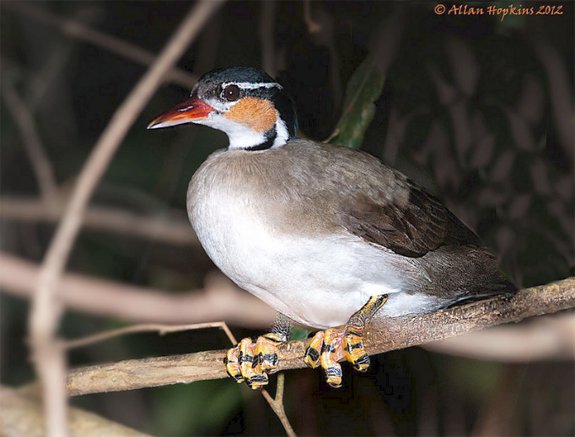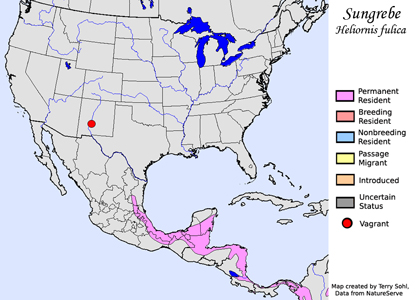| Length: 11.5 to 12 inches | Wingspan: 18-20 inches | Seasonality: Non-resident in South Dakota |
| ID Keys: brown upperparts, white underparts, dark crown and nape with white stripes, white throat, long reddish bill. Female has buffy cheek patch. | ||
 The
Sungrebe may look and sometimes act like grebe species, but they are
actually more closely related to Rail species. They are widespread in
South America, Central America, and southeastern Mexico, but normally are
found several hundred miles from the United States. However, in
November, 2008, a lone Sungrebe was found at Bosque del Apache National
Wildlife Refuge in New Mexico. There was some discussion that the bird
may have been an escapee from captivity, but based on it's shy retiring
behavior and a lack of any obvious banding or other signs of former
captivity, the American Orrnithological Union (AOU) accepted the sighting as
a wild bird. The species thus now occupies a spot on the AOU's
official checklist of birds in the North American region (generally U.S. and
Canada).
The
Sungrebe may look and sometimes act like grebe species, but they are
actually more closely related to Rail species. They are widespread in
South America, Central America, and southeastern Mexico, but normally are
found several hundred miles from the United States. However, in
November, 2008, a lone Sungrebe was found at Bosque del Apache National
Wildlife Refuge in New Mexico. There was some discussion that the bird
may have been an escapee from captivity, but based on it's shy retiring
behavior and a lack of any obvious banding or other signs of former
captivity, the American Orrnithological Union (AOU) accepted the sighting as
a wild bird. The species thus now occupies a spot on the AOU's
official checklist of birds in the North American region (generally U.S. and
Canada).
The Sungrebe is known for a unique anatomical adaptation in the males. They have a unique fold of skin under their wings that allows them to carry young. The Sungrebe, the only member of the Heliornis genus, is the only bird known to have this adaptation.
Habitat: Found in slow moving streams and rivers, generally in and around heavy vegetative cover. They are sometime adaptable to more temporary water sources such as flooded fields and ditches.
Diet: The diet of a Sungrebe is not well understood, but they are known to feed on molluscs, insects, spiders, small crabs and other crustaceans, and small reptiles and amphibians.
Behavior: While not a grebe species, they do often move through the water like a grebe or Anhinga, with their bodies partially or mostly submerged. They are capable of strong flight but will often simply slink away through the water rather than flush and fly away when threatened. Foraging is primarily done at the surface of the water, picking up food items from the water's surface, just under the surface, or on nearby vegetation.
Nesting: The nest of a Sungrebe is constructed by both the male and female. The nest is a platform of sticks and reeds, lined with leaves, mosses or other material. The nest is placed in vegetation near a water body, generally quite near the water's surface. The female lays 2 to 4 eggs, and both the male and female help to incubate them. Both parents help to raise the young, although the male may care for them more than the female.
Song: Multiple vocalizations have been heard, from soft clucking of courting birds, to loud, multi-note calls with rising tones in the 2nd syllable of each 2-syllable note.
Migration: Considered a permanent resident throughout their normal range.
Interactive eBird map: Click here to access an interactive eBird map of Sungrebe sightings
Similar Species: Distinctive if seen well.
Conservation Status: The Sungrebe is considered a species of "least concern" by the IUCN. They are found over a wide geographic range, and are common in parts of their range.
Further Information: 1) BirdLife International - Sungrebe
2) Cornell's NeoTropical Birds - Sungrebe
3) The Guardian - Mystery Bird-Sungrebe
Photo Information: Photo by Allan Hopkins - Taken in Guyana in South America - Photo licensed under Creative Commons Attribution/Non-Commercial/NoDerivs 2.0 Generic License
| Click below for a higher-resolution map |
 |
| South Dakota Status: Non-resident in South Dakota |
Additional Sungrebe Photos (coming soon!!)
